 | ||
Turbochargers are commonly used in passenger cars to obtain greater power output from a given engine size. The compact nature of a turbocharger means it is often a more space-efficient solution for increasing power output than increasing engine displacement. As an example, the turbo Porsche 944's acceleration performance was very similar to that of the larger-engine naturally aspirated Porsche 928. Although turbocharging is less responsive than supercharging, turbocharging is generally considered more efficient than supercharging. New techniques such as twin-turbo/biturbo (whether parallel or sequential) setups and twin-scroll turbocharger, in combination with technologies such as variable valve timing and direct fuel injection, have cut down on turbo lag.
Contents
History
Since 1978, many manufacturers have produced turbocharged cars.
Notably in the mid-2000s, BMW which long used small-displacement high-rev naturally aspirated engines, re-introduced its turbocharged gasoline engine, the BMW N54.
Parallel
Some engines, such as V-type engines, utilize two identically sized, each fed by a separate set of exhaust streams from the engine. Having two smaller turbos produce the same aggregate amount of boost as a larger single turbo allows them to reach their optimal rpm, more quickly, thus improving boost delivery. Such an arrangement of turbos is typically referred to as a parallel twin-turbo system. The first production automobile with parallel twin turbochargers was the Maserati Biturbo of the early 1980s.
Sequential
Another twin-turbo arrangement is "sequential", where one turbo is active across the entire rev range of the engine and the other activates at higher rpm. Below this rpm, both exhaust and air inlet of the secondary turbo are closed. Being individually smaller they have reduced lag and having the second turbo operating at a higher rpm range allows it to get to full rotational speed before it is required. Such combinations are referred to as a sequential twin-turbo. Cars using sequential twin-turbos include the Porsche 959, Mazda RX-7, Toyota Supra and Subaru Legacy. Sequential twin-turbos are usually much more complicated than a single or parallel twin-turbo systems because they require three sets of intake and waste gate pipes and valves to control the direction of the exhaust gases.
Triple-turbo
BMW's diesel N57S is the only tri-turbo engine currently available.
Quad-turbo
The Bugatti Veyron uses a quad-turbo W16 engine. The Bugatti EB110 from 1991 uses a quad-turbo V12.
Beginnings
The Offenhauser turbocharged engine was one of the early uses of turbocharging in motorsport, when it competed at the Indianapolis 500 in 1966, with victories coming in 1968 using a Garrett AiResearch turbocharger. The Offenhauser turbo peaked at over 1,000 hp (750 kW) in 1973, which led USAC to limit boost pressure. In their turn, Porsche dominated the Can-Am series with a 1,100 hp (820 kW) 917/30. Turbocharged cars dominated the 24 Hours of Le Mans between 1976 and 1988, and then from 2000 to 2007.
Formula 1
In Formula One, in the so-called "Turbo Era" of 1977 until 1988, Renault, Honda, BMW, and Ferrari produced engines with a capacity of 1,500 cc (92 cu in) able to generate 1,000 to 1,500 horsepower (750 to 1,120 kW). Renault was the first manufacturer to apply turbo technology in F1. Turbocharged engines dominated and ended the Cosworth DFV era in the mid-1980s. In 1987, FIA decided to limit the maximum boost before the technology was banned for 1989. Rule changes for the 2014 season marked a return of turbocharged engines to the sport, from the previous normally aspirated 2.4 litre V8 engines to turbocharged 1.6 litre V6 engines.
Rally
During the Group B era of the 1980s, turbocharged engines producing up to 600 hp (450 kW) dominated the World Rally Championship.
For the 2012 season, WRC rally cars use a 1.6 litre turbocharged engine with a 34 mm restrictor.
Motorcycles
In 1978 Kawasaki offered the Z1R-TC, a stock ZR1 fitted with an American Turbo Pak compressor to give it turbo power. The first production turbocharged motorcycle was Honda's 1982 CX500T. It has a maximum engine speed of 9,000 rpm.
One of the last production turbocharged motorcycles was the 1983-1985 Kawasaki GPZ750 Turbo.
